Graphene Materials: Fundamentals and Emerging Applications
Giới thiệu về sách điện tử này
The book discusses the various methods that have been developed for the preparation and functionalization of single-layered graphene nanosheets. These form the essential building blocks for the bottom-up architecture of various graphene materials because they possess unique physico-chemical properties such as large surface areas, good conductivity and mechanical strength, high thermal stability and desirable flexibility. The electronic behavior in graphene, such as dirac fermions obtained due to the interaction with the ions of the lattice, has led to the discovery of novel miracles like Klein tunneling in carbon-based solid state systems and the so-called half-integer quantum Hall effect. The combination of these properties makes graphene a highly desirable material for applications.
In particular, Graphene Materials: Fundamentals and Emerging Applications has chapters covering:
- Graphene and related two-dimensional nanomaterials
- Surface functionalization of graphene
- Functional three-dimensional graphene networks
- Covalent graphene-polymer nanocomposites
- Magnesium matrix composites reinforced with graphene nanoplatelets
- Graphene derivatives for energy storage
- Graphene nanocomposite for high performance supercapacitors
- Graphene nanocomposite-based bulk hetro-junction solar cells
- Graphene bimetallic nanocatalysts foam for energy storage and biosensing
- Graphene nanocomposites-based for electrochemical sensors
- Graphene electrodes for health and environmental monitoring
Giới thiệu tác giả
Ashutosh Tiwari is an Associate Professor at the Biosensors and Bioelectronics Centre, Linköping University, Sweden; Editor-in-Chief, Advanced Materials Letters; Secretary General, International Association of Advanced Materials; a materials chemist and also a docent in applied physics at Linköping University, Sweden. He has published more than 350 articles, patents, and conference proceedings in the field of materials science and technology and has edited/authored more than fifteen books on the advanced state-of-the-art of materials science. He is a founding member of the Advanced Materials World Congress and the Indian Materials Congress.
Mikael Syväjärvi received a PhD degree in materials science from Linköping University, Sweden in 1999. His expertise is in materials growth and technologies of SiC, graphene and related materials. His scientific focus area is material for energy and environment. Dr. Syväjärvi initiated a European research collaboration in fluorescent and photovoltaic SiC and has co-organized several symposiums at E-MRS. He has published more than 200 journal and conference papers. He is a co-inventor of The Cubic Sublimation Method for cubic SiC and the Fast Sublimation Growth Process that is applied for industrial development of fluorescent hexagonal SiC. He also co-invented the High Temperature Graphene and co-founded Graphensic AB that manufactures and supplies graphene on SiC.






